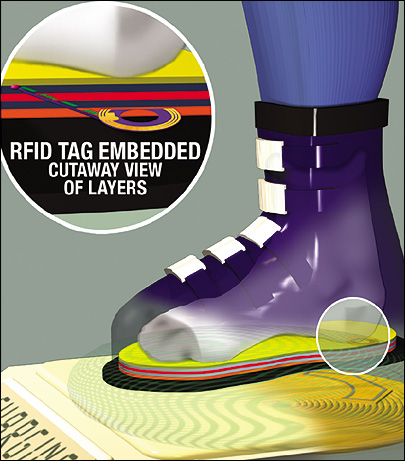Skiers and snowboarders might want to sign up for preseason conditioning classes. If Thermal Solutions is able to bring its heat-holding insoles to market, boots will keep feet toasty for hours of schussing. The system, which is in the prototype stage, uses a combination of RFID and magnetic-induction heating. Skiers insert the insoles in their boots and then step onto a control unit that contains an interrogator.
Each insole has an embedded Tagsys high-frequency (13.56 MHz) tag that transmits instructions to the interrogator for a target temperature. The skier selects one of three settings—hot, medium or warm—from a dial on the control unit. Medium is the target temperature encoded to the tag, while hot will add a couple of degrees and low will subtract a couple. The insole also contains graphite, a highly conductive mineral.

The control unit has an inverter that converts direct current to a high-frequency alternating current, which it sends through a copper coil in the control unit, producing an alternating magnetic field. The graphite inside the insole heats up through magnetic induction—so only the insole gets hot, not the boot. The tag has an integrated temperature sensor, which the control unit reads when emitting the magnetic field. The system will warm the insole to within 1 degree Celsius of the target temperature encoded to the tag, according to Thermal Solutions’ director of technology, Michael Bourke.
The insole heats up in about one minute, and a display tells the skier when it has reached its target temperature. Once the boot is removed from the control unit, layers of heat-retaining material inside the insole discharge the heat over the next four hours. The insole’s top layer releases heat at body temperature, so feet don’t get overheated.
Similar boot heaters already on the market use external battery packs to generate warmth, but these require new or recharged batteries for each use, and cost up to $200. Thermal Solutions is hoping to bring its insole to market at roughly $14 a pair. The control unit costs $200, but the company would like to see ski areas install them in lodges so skiers can just heat up on-site. As their toes start to chill, they could come in for a hot cocoa and recharge their feet for the rest of the day—or as long as their muscles allow.

